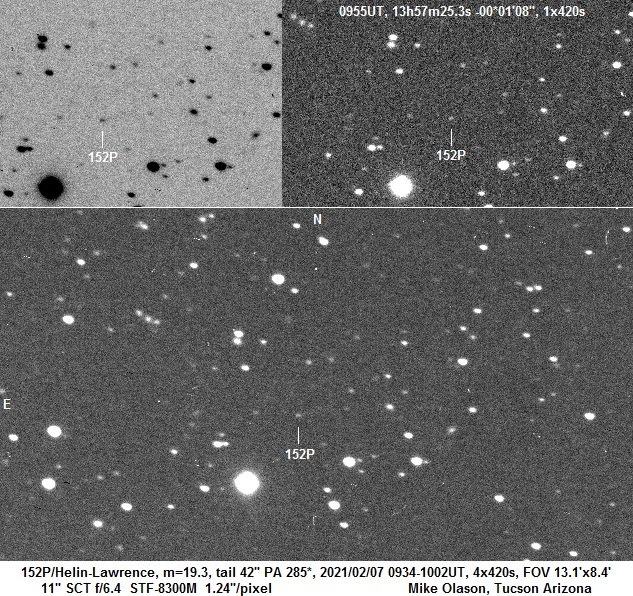Current Info for Observer
as of 07/27/2024 7:25 a.m.
Please login to view current observation details
General Info
as of 07/27/2024 7:25 a.m.
| Type | Comet |
| Constellation | Cetus |
| Magnitude | 21.96 |
| Peak Magnitude | 18.42 (June 30, 2003) |
| Orbits | Sun |
| Right ascension | 2:25:42.60 (Hours) |
| Declination | 4:33:16.9 (Deg) |
| Distance from Earth | 4.92009AU |
| Closest Approach | April 24, 2002 (2.401AU) |
| Distance from Sun | 5.00915AU |
| Elongation | -89:09:27.8 |
☉ Solar Masses ⊕ Earth Masses j Jupiter Masses
11" SCT f/6.4 and STF-8300M CCD Camera
1 points
Comet 152P/Helin-Lawrence now has a very faint slim 0.012 degree long tail pointing WNW of the coma which isn't bad for such a faint comet. In these images the comet is only magnitude 19.3 and is 288 million miles from Earth. 152P will reach perihelion in its 9.48 year orbit in January 2022 but it won't brighten to magnitude 16 until the summer of 2022.
Generate a finder chart
The following form will generate a PDF finder chart suitable for printing using to locate objects in the sky with your telescope!
The Date is only really useful for solar system objects, as deep space objects move measurably only on a galactic timescale.
The larger the F.O.V (field of view), the more "zoomed out" the object will appear. It can be helpful to print several charts of the same object with different field of views.
Limiting the magnitude (remember, lower magnitude means brighter!) of stars and objects can make sure your chart is not cluttered with dim objects that you may not be visible to you anyway. The defaults are good, but try experimenting with raising and lowering the values.
Please login to post comments
